CHAPTER 22
Butler University
While ABT was off on a 1979 tour to Europe a call came out of the
blue. The Dean of the Jordan College of Music at Butler University
in Indianapolis, Indiana wanted to know if I would be interested in
becoming a Professor of dance at this prestigious University.
It was somewhat bizarre to think that I, who had never been to
College, or even graduated from High School for that matter, could
become a College professor. Improbable, but I felt I was basically a
scholar, so, could this be the direction I should go?
They flew me out to Indianapolis for a day,
fully scheduled and squeezed with introductions; lunch with the
Dean, dinner with the dance faculty, meetings, interviews plus
teaching a one-shot ballet class. It was all clearly designed to
look me over before considering hiring me.
On the plane back to New York I started to question myself if I
should really take the job, even if they invited me to. Indianapolis
seemed very isolated. Then a contract arrived and I had a Hobson’s
choice. Should I leave ABT, New York City and all my friends to
teach in a mid-Western University? On the other hand, being a
University Professor was certainly a more stable occupation than the
haphazard life of a roaming choreologist. And how long would ABT
even last, considering the turmoil it was then going through? I
signed the contract, but kind of reluctantly. Meanwhile, I was to
stage my “Firebird” in New Jersey and then to San Antonio to stage a
full-length “Coppelia”.
A Summer Intensive In
Canada
During the summer I had an invitation to teach a 4-week Summer
Intensive in Toronto, Canada. It was run by Diana Jablokovo-Vorps, a
Russian lady. The students were rather good too. Considering my
mysterious origins with an unknown father from that country I
considered myself half Canadian anyway. My classes were successful
and I seemed to be well liked, plus it was there that I taught my
first, real character classes.
Character Dance
There was already a character dance teacher coming to teach a
guest class. Elena Zhuralyeva was formerly of the Moiseyev company
in Moscow. I couldn’t wait to meet her and to watch her class. Tape
recorder and note pad in hand, I thought I must get it all down and
watched her class intently. After she left I had a big surprise when
they asked to teach a character class every day. Well, I didn’t feel
I could in any way match a former dancer from the Moiseyev and spent
a whole morning in my room preparing my first lesson, trying to
remember as best I could Lazovsky’s classes that I did as a boy at
the Ballet Theater school.
Oddly enough, for some reason I had brought a
pair of Russian character boots with me from New York, but what
about music? I rushed to the Toronto Public Library and somehow
managed to take out a book of Bulgarian folk dances for my pianist.
The class was an unexpected success, in fact the students told
around that they enjoyed my class far better than that of Zhuralyeva,
who had been far too serious and strict. So that was the
extemporaneous beginning of my second career as a character dance
teacher.
National Ballet Of Canada
On a day off I visited the National Ballet Of Canada studios in a
magnificent building in downtown Toronto. Alexander Grant, a
long-time principal with Britain’s Royal Ballet was the Director. In
his office we had a pleasant chat, ending with him inviting me to
join his company as choreologist. All the signs were there to do so,
but having already signed the Butler contract I had to refuse. Mme
Vorps had also wanted me to stay on to teach permanently at her
school and had emphatically told me that I would never be happy
teaching in a University. Now I began to wonder if I had made the
right decision? At any rate, in September I left for Indianapolis to
begin my new life as an Associate Professor.
The Jordan College of Fine Arts at Butler
University
It’s difficult for me to write about Butler University. Diana
Jablokova-Vorps in Toronto was absolutely right when she told me
that teaching at a College would be un-rewarding. It was not a happy
experience.
Although Butler’s dance department was
considered to be one of the best in the country, it had an insular,
provincial atmosphere. My colleagues, it seemed to me, had been
there forever. For one thing, they didn’t want to hear or know
anything about how ballet technique had advanced or what was being
done in New York City, the very Capitol of the dance world.
My Colleagues
The meddlesome woman who headed the dance department, Martha Cornick,
also taught an occasional modern dance class, though I couldn’t even
imagine her as a dancer. She must have had closets filled with
outfits from the 1940s and wore a different one every day, all with
Joan Crawford shoulders. Like a Hungarian csardas dancer, she
had a habit of placing her right hand, palm up, at the back of her
head every few minutes, not to dance but to fondle her hair. As far
as I could see, her main talent was searching for and finding course
numbers in a huge pile of papers cradled in her left arm. Flicking
through them with the other hand so rapidly it was cause to stare in
wonder at how she managed to spot whatever she was looking for. She
also, unasked, picked up my mail every morning and delivered it to
my office, I suspected as an excuse to find out who was writing to
me.
Betty Gour’s claim to fame was that she had
once danced in the original “Oklahoma” on Broadway, way back in
1942, but her figure had somehow morphed into a tub. The story went
around that Agnes de Mille didn’t even recognize her when she once
visited Butler.
Always wearing a green polka dot dress and silver pumps, she taught
her classes like a frontier schoolmarm. She relentlessly yelled the
dance counts in class and took a dislike of me from the start when I
was asked to take over the Slavic dance classes that she had always
taught. She announced to students behind my back that the seven port
de bras of the Vaganova technique that I taught were never really
set. Indeed they are and my teacher at American Ballet Theater
school, Mme, Valentina Peryaslavec from whom I learned Vaganova
would have gasped at this new information. Several former students
from Butler have written me after reading this book. All agreed
about my descriptions of these teachers and offered their own
memories. I had forgotten that Betty Gour, besides backstabbing,
pushed another trade as a devoted Avon lady. She sold from her
office. Girl students would line up at her door to buy her Avon
products in hopes of thereby getting a passing grade. Like the other
dance professors, she had bought a house near campus but it was
impossible to reach her at home after seven in the evening as she
would already by then be in her cups.
Peggy Dorsey, had actually started the dance
department and was the most approachable. She was Swedish by birth
but grew up in England, therefore had English manners and
friendliness. With her I felt right at home.
Bud Kerwin, taught jazz as well as ballet. He
had a friendly air about him and went to Paris every summer to teach
jazz dance. He was very popular with the students and was the last
to remain at Butler after the rest had either left or had died.
William Glenn was the unofficial dean of the dance department. He
had been there the longest, along with his side-kick, George Verdak.
Both of them had a dance background in the corps of Ballet Russe.
Verdak’s reason for leaving Butler was to start the Indianapolis
Ballet Theater, which was the reason for the vacancy I was to fill.
Mr. Glenn had an envied accomplishment that
few other ballet teachers had; he was able to teach while playing
the piano, and played it very well too and I think he enjoyed that
more than the actual teaching. I envied him this accomplishment, but
his teaching methods were extremely old fashioned. Once he was
showing me a film of a Nutcracker that Butler had done in the past.
Suddenly the principal male dancer appeared on screen, rushing to
center stage. The figure and movements were so comic I burst out
laughing and asked who on earth could it be. I thought it must be a
first year student and cringed when he said it was himself.
Mr. Glenn was basically a kind man but
possibly resented me replacing his long time friend Mr. Verdak.
Their houses were so close beside each other that they could
literally step from one window into the other, and did. It’s not a
good idea, as I was to later find out, to be the first to step into
a position long occupied by anyone of long standing. A good example
is Marcie Haydee who, to be head of the Stuttgart Ballet was wise
not to be the first one to replace John Cranko after his death, but
to be the second.
George Verdak had in the past been the most
influential member of the dance faculty and had produced some very
interesting ballets. Mr. V, as he was called, was also a scholar,
spoke Russian and had a collection of ballet music scores that was
so large he had to construct a special building behind his house to
contain it.
Ballet Russe Sets and
Costumes
September to December was the longest haul, ending with a shabby
Nutcracker, using the outworn, tattered Ballet Russe sets and
costumes. There was no one there who could really identify most of
the scenery in store; which ballets they were from or who designed
them. The massive collection of costumes were also unidentified and
nearly falling apart, stored next to an overly heated boiler room.
Somehow, and I never did learn all the reasons
behind it, George Verdak had managed to end up with all the scenery
and costumes from the defunct Ballet Russe de Monte Carlo company
which he stored at the University. It had accumulated over the span
of several years during the mid-sixties through his diligence.
This vast collection was housed in various
storage locations – basements of other buildings where humidity
conditions were not controlled, Quonset huts, unused storage rooms.
It was really a mess. Confusion reigned too, ending in battles as to
who owned all of this massive collection, Verdak or Butler
University. . (Thankfully, I think this collection of Ballet Russe
scenery has now finally all been identified.)
Classes
My classes went very well, especially the twice weekly Slavic
character class. The piano accompanists were a big problem. They
were basically students from the music department who used the
ballet classes as a means to practice their own assignments and had
no concept of what was needed for a ballet or character class. When
I had to teach an eight in the morning class for non-majors, who
were not only beginners but hardly awake, pianists played what to me
sounded like hymns, which nearly made us all feel like going back to
sleep.
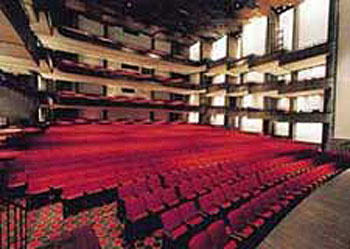 Trying
to remedy this, I gave one pianist some proper music for a ballet
class, to take home and practice. The next day she played it
perfectly, but rather than understanding that it was only to be an
indication of how a variety of music should be available, she
continued playing the very same music for every single class
throughout the entire semester until we were all sick of it! Trying
to remedy this, I gave one pianist some proper music for a ballet
class, to take home and practice. The next day she played it
perfectly, but rather than understanding that it was only to be an
indication of how a variety of music should be available, she
continued playing the very same music for every single class
throughout the entire semester until we were all sick of it!
Photo: Clowes Hall interior, Butler University
The well attended performances were given next
door at Clowes Hall, where the Indianapolis Symphony performed as
well as visiting companies. The Symphony Orchestra played for our
ballets as well.
Graduation Ball in Memphis
At Christmas vacation I flew back to New York where I still kept my
apartment in Southgate Tower. I used most of the time-off preparing
“Graduation Ball” to stage during a weekend stop-over in Memphis on
the return trip to Indianapolis. Grad Ball, with music by Johann
Strauss and choreography by David Lichine was in the ABT repertory
and I had learned and notated it while there.
I had danced in Memphis once before as it was
one of the stops on the Metropolitan Opera tour. This time, being
there such a short time, I only saw the dance studio and the hotel
where I was more or less quarantined with rock groups on every floor
who kept me awake all night with their racket and utter destruction
of everything in sight.
The Memphis Ballet was run by the Tevlins, a
nice young married couple and former students at Butler. I never got
to see the performance but heard it was a tremendous success.
Kenneth Melville, a former dancer with Britain’s Royal Ballet danced
the comic, drag role of the Head Mistress. Not too long afterwards
he died.
La Bayadère
During the second term there were two more productions for Butler
Ballet that I had to do, with the Indianapolis Symphony. I decided
to stage “La Bayadère”, the final act. I knew it well, having staged
it already in San Francisco for Ballet Celeste, in Birmingham and at
Florida State University where I had used a notation score of the
Bolshoi version. Plus, I had just notated the version staged by
Natalia Makarova for ABT. The shade scene in the third act is
considered one of Petipa’s masterpieces.
It begins with twenty-four girls progressing
one by one down a ramp, symbolizing the Himalayan mountains. Their
step, [a slow arabesque penchée followed by a temps lié
back], takes about ten minutes before they all reach their positions
on stage to continue this very effective scene.
The leading ballerina, Nikia that I chose was
one of the best in the student body and matched the muscular boy who
could manage the one arm lifts as Solor. Also three solo girls. The
other professors thought I must be out of my mind to stage something
as challenging as this during only my second term, but it worked out
splendidly and even the dour Betty Gour commented afterwards that,
contrary to her first concern, it had worked out beautifully.
La Sylphide
After “La Bayadère” I started on “La Sylphide [not to be confused
with “Les Sylphides”]. I had notated this entire two act Danish
ballet at ABT, while Natasha Makarova and Ivan Nage were dancing it.
Eric Bruhn had staged it for ABT himself, having danced it many
times in Denmark. Like “Giselle”, it is a perfect example of ballet
during the age of Romanticism in the early nineteenth century.
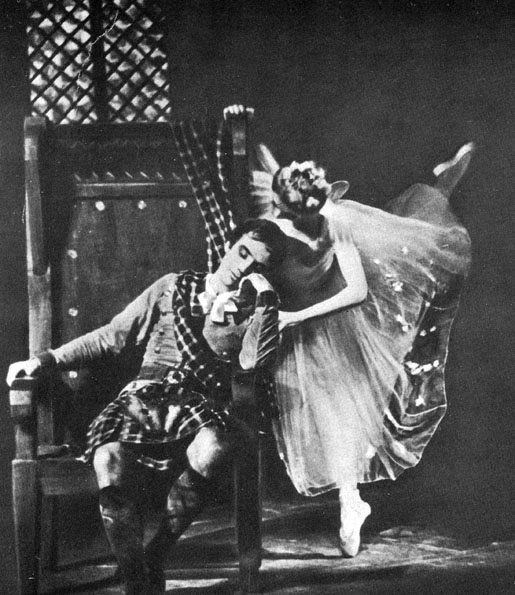 The
curtain rises on a large room in a gloomy Scottish homestead. James,
a young Highlander is to wed Effie. He is dozing in an armchair by
the fire when a Sylphide [a nymph] appears, dances around him and
wakes him with a kiss. Enamored, he tries to pursue her but she
eludes his grasp and disappears into the fireplace and up the
chimney. The
curtain rises on a large room in a gloomy Scottish homestead. James,
a young Highlander is to wed Effie. He is dozing in an armchair by
the fire when a Sylphide [a nymph] appears, dances around him and
wakes him with a kiss. Enamored, he tries to pursue her but she
eludes his grasp and disappears into the fireplace and up the
chimney.
Photo: La Sylphide hovers over a sleeping James
Guests arrive and preparations are made for the wedding. James
however, is preoccupied, haunted by the vision of the Sylphide.
An old witch, Madge comes in to tell fortunes. She predicts that
Effie will not marry James but his rival Gurn instead. Furiously,
James sends her from the house and she vows vengeance. During a
Highland fling the Sylphide appears again, but is visible only to
James. She snatches the wedding ring from him and disappears into
the forest. He follows her, abandoning the heart-broken Effie.
The second act is in the forest, home of the Sylphs. Madge and
her witches are dancing around a giant cauldron into which a magic
scarf is stirred. James enters, exhausted and forlorn, unable to
find the Sylphide. She soon comes with other Sylphs. He accepts the
magic scarf from the witch because she tells him it will bind his
love. When the Sylphide returns, he drapes it around her shoulders.
Her wings drop off and she falls lifeless. She is carried away into
the tree-tops by her mourning companions while the distraught James
sees in the distance the wedding procession of Effie and Gurn.
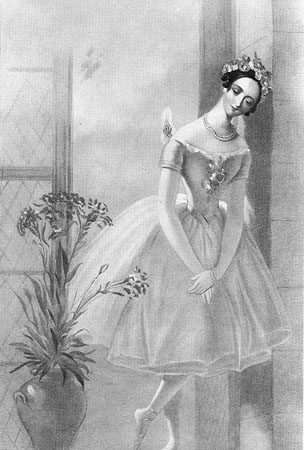 This Bournonville version, first mounted in Copenhagen in 1836
still retains the French style of the nineteenth century and is the
most perfect survival of a ballet from the Romantic period to be
seen today. This Bournonville version, first mounted in Copenhagen in 1836
still retains the French style of the nineteenth century and is the
most perfect survival of a ballet from the Romantic period to be
seen today.
Photo: The first La Sylphide, Marie Taglioni
The original music score by Herman Lovenskjold
had been wonderfully re-orchestrated for ABT by John Lanchbury, a
conductor/composer and a wonderful arranger of music especially for
dance. Among other things he arranged and composed parts of the
music for Ashton’s ever popular ‘La Fille Mal Gardée”. He wrote the
score for “Tales Of Beatrix Potter" and many other ballets, plus
music for films. He instinctively understood dance and his
orchestration for “La Sylphide” had not been published or available,
only to ABT, but when I called him to ask for the orchestral parts
he was delighted to let me have them on loan. So it was not only the
authentic choreography of this famous romantic ballet I was able to
offer, but also the means for the Indianapolis Symphony to be able
to play it.
Being completely unaware of the value of this
boon, these remarkable assets all went by entirely un-recognized by
those at Butler, as if it was just another, every-day passing event.
Technical Aspects of La Sylphide
The ballet, being placed in Scotland required lots of
plaid material and patterns for the boy’s kilts. Finding plaid
fabric in Indianapolis wasn’t at all easy. There plenty of fabric
stores but it just wasn’t in fashion that year.
Then there was the fireplace in Act One that
had to have a specially built chimney that the Sylphide could fly
up. This is done by two stage-hands standing on a scaffold behind
the fireplace, reaching down and taking her hands and simply pulling
her up. To the audience it looks exactly as if she were flying
upwards.
However, stage-hands at Clowes Hall for some
reason, possibly union rules, refused to do this, so the Sylphide
had to merely run into the fireplace and off with no flying effect.
The chair into which the Sylphide has to
disappear through a false back had to be constructed. This was done
by some senior boys but I had to first design it. The cauldron at
the beginning of Act Two had to be huge so that Madge could stand
above it while the eight witches could dance around it. What I got
was a series of larger and larger pots that eventually resulted in
me having to construct a giant one out of papier mâché.
Scenery, including a tree that the Sylphide
had to ascend, was not a problem as there were plenty of Ballet
Russe back-drops available to choose from, if one was willing to do
the search. For Act Two I found what was really the second act from
the Ballet Russe “Swan Lake”.
My Slip-Up
Apart from graduating from the London Institute with what was
basically the equivalent of a Bachelor of Arts Degree, I had never
been to College myself, let alone being a Professor at one. But none
of the others had either. A background in dance was apparently
enough at that time. For starters, I had no idea how to grade the
students. William Glenn had promised to guide me through these ins
and outs of college procedures. It was a mistake to have believed
him.
Of the three major productions I did that
first year, the casting of La Sylphide became my biggest mistake in
that I trusted the advice of Mr. Glenn.
In my classes was a girl who seemed just made
for the role of La Sylphide. The only problem: she was not a member
of the regular student body but only came in for classes now and
then.
I made a point to ask Mr. Glenn if it would be permissible to use
this girl. After all, he had claimed he would guide me in anything I
was unfamiliar with. I trusted him, but should have known better.
Who I should have cast in this leading role
was a particular Senior girl about to graduate, the one I had
already cast in the role of Effie. She happened to be perfect as
Effie but really had her heart set on the Sylphide role and that it
should have rightly been hers. Of course it should have. Glenn had
steered me wrong, either thoughtlessly or underhandedly, I never
knew which.
This young lady took the entire incident as a personal insult and
even though she danced the Effie role faultlessly, went about
recriminating me for the rest of the semester.
All the work put in on this ballet, along with its many problems and
scruples had only one performance and passed by uneventfully with
un-enthusiastic applause. The audience was not at all familiar with
the Age of Romanticism.
A Very Different Alice in Wonderland
During the year I had taught some classes for students at The Jordan
Academy. This was an affiliate dance school of Butler University and
was located in a beautiful, French style building not far from the
Butler campus. I was asked to choreograph their annual recital.
My “Alice in Wonderland And Through The Looking Glass” seemed like a
good choice. I could use all of the hundred or so children at the
Jordan School as well as some of my Senior students at Butler, as
guests.
Putting on the production required first
trying out 200 children with widely divergent skills, altering the
ballet to include as many of these students as possible and working
with the masses of mothers that accompany such children. It was a
night of try-outs that lasted until 1 AM.
Thinking back to the Minerva days in England when I danced several
roles in this ballet, then the productions I did first in Oregon,
then for PBS in Tucson, I already had a ready-made production, but I
wanted to do a completely new version.
For one thing, I thought that Lewis Carroll,
the author of “Alice”, should be the leading character and not
Alice. Angelo Woodman, one of my best Senior students took the role.
He opened the ballet, unlike in the book that opens with Alice and
her Sister by the riverbank. The two-acter closed with him and Alice
in a grand pas de deux, just before her coronation. He also danced
the Mad Hatter, a role I had danced in the TV version. In fact, I
had Lewis Carroll popping up in various guises throughout.
It was a spectacular production on the huge
stage of Clowes Hall but being basically a recital, only parents and
friends saw it.
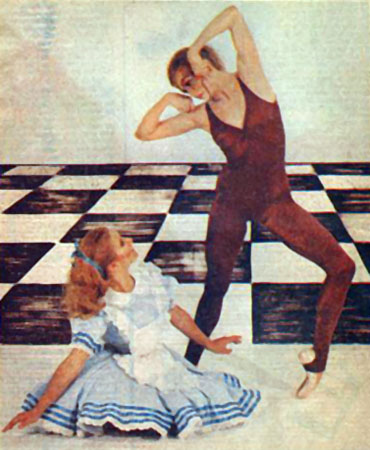

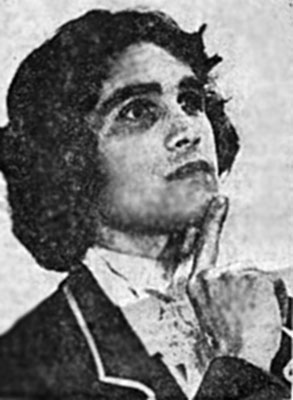
Photos: Left, Alice encounters the Mock Turtle
Middle: Alice, frightened while growing 20 feet tall
Right, Angelo Woodman as Lewis Carroll
“Paquita” In Salt Lake City
During the Summer vacation I staged “Paquita” for Ballet West in
Salt Lake City.
This assignment came about through the Dance Notation Bureau. Bruce
Marks, a former star of ABT was running Ballet West, a first-rate
company. He wanted the old Maryinsky version of Paquita and asked
the Bureau if they had it available. They had. I was the one who
notated it.
When I arrived in Salt Lake, Frederic Franklin, the long-time
star of Ballet Russe de Monte Carlo, was just finished staging “Raymonda”.
Also, Danny Levens, who had just finished a starring role in “The
Turning Point” was also staging one of his own ballets. We all were
staying at the same hotel, near the Mormon Tabernacle Square and
usually had breakfasts together.
Ballet West had its own theater, a gorgeous former movie palace
that had been re-modeled, with rehearsal studios on the top floors.
.
Back at Butler for the Fall semester, not one of my colleagues had
the slightest interest in asking how “Paquita” went. William Glenn
had also just staged a Paquita for the Indianapolis Ballet Theater
that he invited me to see. If he had intended to stage an authentic
re-construction, the choreography was completely wrong, but I
offered no comments other than complimentary.
Cinderella, My Big Finale
For the Christmas holiday ballet, instead of the
usual and boring “Nutcracker” that Butler produced every year, I
suggested “Cinderella”. My three-act version was based on that of
the Bolshoi, in concept but not the choreography, which was my own.
It turned out to be a welcome change with sold out houses for every
performance. Audiences were lined up all around Clowes Hall to see
it and the Indianapolis Symphony players were delighted in playing
the Prokoviev score.
The sets were designed and executed by Karl
Kaufman, using my suggestion of a lavender motif. It made a lot of
money yet I never received one thank-you, not one picture or video.
Bob Joffrey had promised to fly in to see the production but I
didn’t dare have him meet Dr. Cornick who would only put me down.
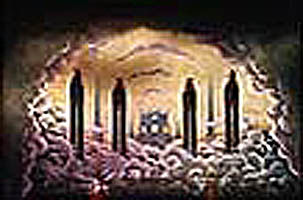 The only picture I managed to find was many years later, among a
collection of the Ballet Russe scenery on Butler’s internet site.
Butler had finally managed to identify and put in order its
collection. It’s the third act backdrop of my own “Cinderella”, but
with no credit. The only picture I managed to find was many years later, among a
collection of the Ballet Russe scenery on Butler’s internet site.
Butler had finally managed to identify and put in order its
collection. It’s the third act backdrop of my own “Cinderella”, but
with no credit.
Photo: “Cinderella” Act-Three back-drop
Butler’s “Cinderella” Ballet is Brilliant
“The most splendiferous entertainment in the city this weekend is
the Butler Ballet production of Cinderella to Prokoviev’s music on
the stage at Clowes Hall. It has a cast of 60 dancers, a pit
orchestra of 87 instrumentalists and costumes and sets that the
great Ziegfield himself probably could not have afforded, at today’s
prices. Certainly no traveling ballet company can put on such a
spectacle.
Richard Holden provided the brilliant choreography and staging, with
scenic designs by Karl Kaufman. While the show is visually dazzling,
the dancers are not overwhelmed by all that magnificence. There are
so many good ones that we can’t possibly name them all – we hope
their teachers will tell them who they are.
There is at least one handsome set for each of the ballet’s three
acts, and more in the last when there is a change for every stop,
from Spain to Egypt, that the Prince makes in his search for
Cinderella. This Cinderella could become as traditional as the
Nutcracker in the holiday season. The big stage at Clowes Hall is
not often filled with pictures half as wonderful as those
“Cinderella” presents”.
The Indianapolis Star, 12/6/1980
A Classic Car, But I Didn’t Know It
 An
old car belonging to a man across the street had been sitting in his
driveway for months, possibly for years. I bought it for $200: a
Ford Fairlane, circa 1950. It may have been a classic but surely no
bargain, stalling at every stoplight and constantly needed repairs.
While driving along I could even see the street passing beneath
through a hole in the floor! Once, after parking all day on campus,
it decided to only move backwards so I had to drive it all the way
home on back streets, in reverse! I surely could have bought a new
one but somehow in the back of my mind I kept wondering if I was
quite honestly going to stay in Indianapolis. I didn’t. My contract
was not renewed. An
old car belonging to a man across the street had been sitting in his
driveway for months, possibly for years. I bought it for $200: a
Ford Fairlane, circa 1950. It may have been a classic but surely no
bargain, stalling at every stoplight and constantly needed repairs.
While driving along I could even see the street passing beneath
through a hole in the floor! Once, after parking all day on campus,
it decided to only move backwards so I had to drive it all the way
home on back streets, in reverse! I surely could have bought a new
one but somehow in the back of my mind I kept wondering if I was
quite honestly going to stay in Indianapolis. I didn’t. My contract
was not renewed.
 Most
of the students wrote letters to the Dean insisting my classes were
a quantum leap ahead of the others, that the productions I had
mounted were of truly professional quality, that I had introduced
the windfall of Benesh Notation. I had written numerous articles and
reviews for The Indiana Arts Insight magazine - writing being a
scholarly and advantageous thing for a professor to do - but it was
all to no avail. Despite the jealousies and disparagements I endured
while there, I had thought I at last had found my niche and would
spend the rest of my days in Indianapolis. It was not to be. Most
of the students wrote letters to the Dean insisting my classes were
a quantum leap ahead of the others, that the productions I had
mounted were of truly professional quality, that I had introduced
the windfall of Benesh Notation. I had written numerous articles and
reviews for The Indiana Arts Insight magazine - writing being a
scholarly and advantageous thing for a professor to do - but it was
all to no avail. Despite the jealousies and disparagements I endured
while there, I had thought I at last had found my niche and would
spend the rest of my days in Indianapolis. It was not to be.
Photo: At graduation ceremony
“Papa” Beriosov Advises
Nicolas Beriosov, father of the famous ballerina Svetlana Beriosova
and known affectionately as “Papa” by the International dance
community, was esteemed all over the world for his stagings of
ballets from the Diaghilev era.
He was then somewhere in his eighties and, oddly enough, teaching at
the Indiana University in Bloomington, just a few miles South of
Indianapolis. I had driven down there often to see his work; His
productions of “Petrushka” and “L’Épreuve D’Amour” were
masterpieces. Even Robert Joffrey flew in to see them. Papa also
came to my performances and we spoke together often, in Russian.
When I told him I would not be coming back to Butler he said that he
was also not returning to Bloomington and suggested, rather
emphatically, that I should “go to Europe, where you will be more
appreciated.” It was a suggestion I certainly should have followed.
Instead, I rented a U-Haul and, a bit disheartened, drove back to
New York.
|
|
|
|
Copyright ©2006-2021 OKAY Multimedia |
|
|  Trying
to remedy this, I gave one pianist some proper music for a ballet
class, to take home and practice. The next day she played it
perfectly, but rather than understanding that it was only to be an
indication of how a variety of music should be available, she
continued playing the very same music for every single class
throughout the entire semester until we were all sick of it!
Trying
to remedy this, I gave one pianist some proper music for a ballet
class, to take home and practice. The next day she played it
perfectly, but rather than understanding that it was only to be an
indication of how a variety of music should be available, she
continued playing the very same music for every single class
throughout the entire semester until we were all sick of it! The
curtain rises on a large room in a gloomy Scottish homestead. James,
a young Highlander is to wed Effie. He is dozing in an armchair by
the fire when a Sylphide [a nymph] appears, dances around him and
wakes him with a kiss. Enamored, he tries to pursue her but she
eludes his grasp and disappears into the fireplace and up the
chimney.
The
curtain rises on a large room in a gloomy Scottish homestead. James,
a young Highlander is to wed Effie. He is dozing in an armchair by
the fire when a Sylphide [a nymph] appears, dances around him and
wakes him with a kiss. Enamored, he tries to pursue her but she
eludes his grasp and disappears into the fireplace and up the
chimney. This Bournonville version, first mounted in Copenhagen in 1836
still retains the French style of the nineteenth century and is the
most perfect survival of a ballet from the Romantic period to be
seen today.
This Bournonville version, first mounted in Copenhagen in 1836
still retains the French style of the nineteenth century and is the
most perfect survival of a ballet from the Romantic period to be
seen today. 


 The only picture I managed to find was many years later, among a
collection of the Ballet Russe scenery on Butler’s internet site.
Butler had finally managed to identify and put in order its
collection. It’s the third act backdrop of my own “Cinderella”, but
with no credit.
The only picture I managed to find was many years later, among a
collection of the Ballet Russe scenery on Butler’s internet site.
Butler had finally managed to identify and put in order its
collection. It’s the third act backdrop of my own “Cinderella”, but
with no credit. An
old car belonging to a man across the street had been sitting in his
driveway for months, possibly for years. I bought it for $200: a
Ford Fairlane, circa 1950. It may have been a classic but surely no
bargain, stalling at every stoplight and constantly needed repairs.
While driving along I could even see the street passing beneath
through a hole in the floor! Once, after parking all day on campus,
it decided to only move backwards so I had to drive it all the way
home on back streets, in reverse! I surely could have bought a new
one but somehow in the back of my mind I kept wondering if I was
quite honestly going to stay in Indianapolis. I didn’t. My contract
was not renewed.
An
old car belonging to a man across the street had been sitting in his
driveway for months, possibly for years. I bought it for $200: a
Ford Fairlane, circa 1950. It may have been a classic but surely no
bargain, stalling at every stoplight and constantly needed repairs.
While driving along I could even see the street passing beneath
through a hole in the floor! Once, after parking all day on campus,
it decided to only move backwards so I had to drive it all the way
home on back streets, in reverse! I surely could have bought a new
one but somehow in the back of my mind I kept wondering if I was
quite honestly going to stay in Indianapolis. I didn’t. My contract
was not renewed. Most
of the students wrote letters to the Dean insisting my classes were
a quantum leap ahead of the others, that the productions I had
mounted were of truly professional quality, that I had introduced
the windfall of Benesh Notation. I had written numerous articles and
reviews for The Indiana Arts Insight magazine - writing being a
scholarly and advantageous thing for a professor to do - but it was
all to no avail. Despite the jealousies and disparagements I endured
while there, I had thought I at last had found my niche and would
spend the rest of my days in Indianapolis. It was not to be.
Most
of the students wrote letters to the Dean insisting my classes were
a quantum leap ahead of the others, that the productions I had
mounted were of truly professional quality, that I had introduced
the windfall of Benesh Notation. I had written numerous articles and
reviews for The Indiana Arts Insight magazine - writing being a
scholarly and advantageous thing for a professor to do - but it was
all to no avail. Despite the jealousies and disparagements I endured
while there, I had thought I at last had found my niche and would
spend the rest of my days in Indianapolis. It was not to be.